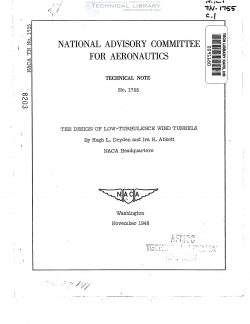naca-tn-1755
- Version
- 102 Downloads
- 1.91 MB File Size
- 1 File Count
- December 8, 2016 Create Date
- December 8, 2016 Last Updated
National Advisory Committee for Aeronautics, Technical Notes - The Design of Low Turbulence Wind Tunnels

Within the past 10 years there have been placed in operation in
the United States four low—turbulence wind tunnels of moderate cross—
sectional area and speed, one at the National Bureau of Standards, two
at the NACA Langley laboratory, and one at the NACA.Ames Laboratory.
In these wind tunnels the magnitude of the turbulent velocity
fluctuations is of the order of 0.0001 to 0.001 times the mean velocity.
The existence of these wind tunnels has made possible the development
of lowedrag wing sections and the experimental demonstration of the
unstable laminar boundaryhdayer oscillations predicted many years ago
by a theory formulated by Tollmien and Schlichting.
The development of the loweturbulence wind tunnels was greatly
dependent on the development of the hotewire anemometer for turbulence
measurements, measurements of the decay of turbulence behind screens,
measurements of the effect of damping screens on wind—tunnel turbulence,
measurements of the flow near a flat plate in air streams of varying
turbulence, and measurements of the drag of specially designed low—drag
airfoils. These investigations were conducted in collaboration with
Schubauer, Skramstad, Jacobs, Vbn Doenhoff and other members of the
staff of the National Bureau of Standards and the National Advisory
Committee for Aeronautics, Vbn Karman and Iiepmann of the California
Institute of Technology, and G. I. Taylor and his colleagues at
Cambridge University.
This paper reviews briefly the state of knowledge in these various
fields and those features of the results which make possible the
attainment of low turbulence in wind tunnels. Specific applications to
two wind tunnels are described.
One of the important tools of airplane design is the wind tunnel, a
tool older than the airplane itself. The increasing complexity of the
airplane—design problem during the last 20 years has stimulated the
continued improvement of wind tunnels and wind—tunnel techniques to
provide data of increasing accuracy and applicability.
| File | Action |
|---|---|
| naca-tn-1755 The Design of Low Turbulence Wind Tunnels.pdf | Download |
Comment On This Post